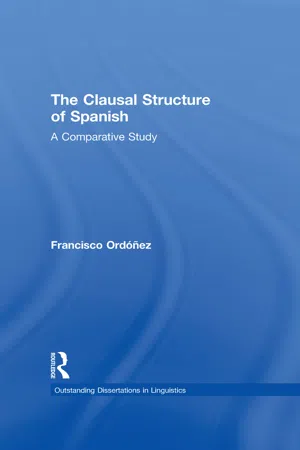This study explores a number of issues involving the clausal structure of Romance with special emphasis on Spanish. The most important theoretical foundation of the study is Kayne’s (1994) antisymmetry proposal, and the relation of hierarchy to linear order found there directly informs Chapters 2, 3 and 4. The analyses in these chapters are not only made possible by the theoretical tools of Kayne (1994). The results also provide support for that proposal. Specifically, the study shows that analyses compatible with antisymmetry provide superior empirical coverage to traditional ones that make use of mechanisms barred by Kayne’s proposal.
1.1 Framework: Antisymmetry
As discussed in the previous section, the most important theoretical foundation of this study is the antisymmetry proposal made by Kayne (1994). The core of antisymmetry is the unification of the two fundamental dimensions of syntax: hierarchical structure and linear ordering of the constituents of a sentence. As a consequence, antisymmetry is more restrictive than previous approaches to syntactic analysis in terms of the theoretical apparatus allowed.
Evidently, this reduction in available mechanisms is a potentially important advance because it makes for a more highly restrictive syntactic theory. Nevertheless, it poses a challenge for the field. Those analyses of empirical facts that had depended until now upon theoretical apparatus barred by antisymmetry must be replaced if the proposal is accepted. Most relevant for this study, a number of these now eliminated mechanisms have been widely assumed in syntactic analyses of Romance until now. At the same time, the plausibility of the theory depends upon the superiority of the alternative analyses. In the end, the success of the new theory rests in good part on the success of these new explanations as much as the explanations depend on the theory. Because of this interdependence, it is important to have a clear idea of the theoretical issues involved.
1.2 Background: Hierarchical Structure and Linear Order
Syntacticians have long distinguished between hierarchical relations and linear order. In generative grammar, hierarchical realtions have traditionally been encoded under the X’-schema as in (1).1
-
Under this schema, the hierarchical arrangement of phrases corresponds to one where every phrase is made up of a head and a complement, which together make an intermediate constituent. This constituent and the specifier form a maximal projection XP. This pattern has been taken to apply to lexical categories (i.e., adjectives, nouns, prepositions, adverbs, and verbs) (Chomsky 1970, Jackendoff 1977, Speas 1990). Recently, it has been extended to complementizers, inflection, and agreement (Pollock 1989, Chomsky 1986).
The other important notion, the order in which constituents appear, has been considered to be a product of language-specific grammars. This less universal approach follows from contrasts such as those between (2) and (3).
(2) a. from Tokyo
b. Sandra hit Mary
(3) a. Tokyo kara (Japanese)
Tokyo from
b. Sandra-ga Mary -o but - ta. (Japanese)
Sandra Mary hit
In these examples, languages such as English and Japanese appear to be mirror images of each other, English being head initial and Japanese head final. Given such variations, it has traditionally been assumed that the hierarchical arrangement between head and complement can have two symmetrical realizations in linear terms. That is, the head may precede as in English, or it can follow the complement as in Japanese:
4
Thus, linear order and hierarchical structure have been taken to be disconnected. To appreciate the radical nature of antisymmetry, it is worth noting that separate treatments of constituent order and hierarchical structure have been a constant in generative linguistics. Although the specific formalizations of both facets of phrase structure have changed considerably over time, there have been few if any attempts at unification.
For example, in its early stages Transformational Grammar encoded both relations through different notations in phrase structure rules. A phrase structure rule such as (5) States that an NP dominates a determiner and a noun, the hierarchal relation being indicated by the arrow. In the same rule the precedence relations were indicated by the ˜ symbol. So the determiner precedes the noun.
5 NP —> Det ˜ N
This over-all separation of hierarchy and linear order was preserved in the development of nontransformational approaches such as GPSG and HPSG. Gazdar, Klein, Pullum, and Sag (1985) and Pollard and Sag (1994) propose Immediate Dominance rules (ID), which express hierarchical relations, and linear precedence statements (LP), to account for order. The same rule (5) would be expressed by the two rules in (6) and (7). The Symbol “—>“ exclusively signifies dominance, whereas “<“ indicates precedence.
6 NP —> Det, N (ID Rule)
7 Det < N (LP Statement)
The GB framework preserved the same separation through the X’ schema presented above. This format expressed that a maximal projection (XP) dominates an intermediate projection (X’) and a XP (a Spec) (Rule 8a). It also expressed the fact that X’ dominates a head and a complement (Rule 8b)
8 a. XP→ XP(Spec) , X’
b. X’→ X0, XP (Complement)
In this approach, hierarchy has been explored with an eye to universals, while variation in order has been accounted for by parameters (Chomsky 1986, pag 91 fn 1). For example the difference between English and Japanese with respect to the order of complements and heads was expressed by the Head Parameter. The Head Parameter States that heads precede their complements in English, but heads follow their complement in Japanese. Travis (1989) takes a further step and proposes that linearity is not only determined by the Head Parameter. She extends concept of linearity to other modules of grammar. On this view, case assignment as well as theta role assignment are sensitive to what it is called directionality. Different settings for the directionality determine different typologies of languages.



